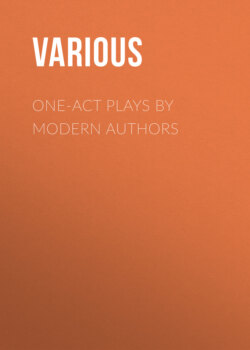Читать книгу One-Act Plays by Modern Authors - Various - Страница 9
На сайте Литреса книга снята с продажи.
THE NEW ART OF THE THEATRE
ОглавлениеTable of Contents
There are certain facts about the artistic transformation that the theatre is undergoing in the twentieth century with which students of the drama need to be familiar in order to picture for themselves how plays can be interpreted by means of design, color, and light. The transformation is definitely connected with a few famous names. In Europe two men, Edward Gordon Craig and Max Reinhardt, stand out as reformers in matters connected with the construction, the lighting, and the design of stage settings. In this country the artists of the theatre are, generally speaking, disciples of one or both of these great Europeans and their colleagues. The new stage artist studies the characterization and the situations in the play, the production of which he is directing, and tries to make his setting suggestive of the physical and emotional atmosphere in which the action of the drama moves.
Gordon Craig has written several books and many articles embodying his ideas on play production. In all his writings he emphasizes the importance of having one individual with complete authority and complete knowledge in charge of coordinating and subordinating the various arts that go to make the production of a play a symmetrical whole, his theory being that there is no one art that can be called to the exclusion of all others the Art of the Theatre: not the acting, not the play, not the setting, not the dance; but that all these properly harmonized through the personality of the director become the Art of the Theatre.
The kind of setting that has become identified in the popular mind with Gordon Craig is the simple monochrome background composed either of draperies or of screens. It is unfortunate that this popular idea should be so limited because, of course, the name of Gordon Craig should carry with it the suggestion of an infinite variety of ways of interpreting the play through design. His screens, built to stand alone, vary in number from one to four and sometimes have as many as ten leaves. They are either made of solid wood or are wooden frames covered with canvas. The screens with narrow leaves may be used to produce curved forms, and screens with broad leaves to enclose large rectangular spaces. The screens are one form of the setting composed of adjustable units, which can be adapted in an infinite variety of ways to the needs of the play.
The new ideas in European stagecraft began to be popularized in America in the year 1914–15, when under the auspices of the Stage Society, Sam Hume, now teaching the arts of the theatre at the University of California, and Kenneth Macgowan, the dramatic critic, arranged an exhibition that was shown in New York, Chicago, and other great centres, of new stage sets designed by Robert Edmond Jones, Sam Hume, and others who have since become famous. The models displayed on this occasion brought before the public for the first time the new method of lighting which, as much as anything else, differentiates the new theatre art from the old. It introduced the device of a concave back wall made of plaster, sometimes called by its German name "horizont," and a lighting equipment that would dye this plaster horizon with colors that melted into one another like the colors in the sky; a stage with "dimmers" for every circuit of lights, and sockets for high-power lamps at any spot from the stage.
In the same year that the Stage Society showed Robert Edmond Jones's models, he was given an opportunity to design the settings and costumes for Granville Barker's production of Anatole France's The Man Who Married a Dumb Wife, which may be said to have advertised the new practices in America more than any other single production.
